Blog: What to Sell on Amazon: 5 Amazon FBA Product Ideas for Daily Planners
What to Sell on Amazon: 5 Amazon FBA Product Ideas for Daily Planners
In this edition of “What to Sell on Amazon”, here’s the Amazon FBA product ideas I’ll be looking at:
- Planner Notebook
-
Personal OrganizersHomeschool Planners -
Bullet JournalsSpiral Journals - Graph Paper Journal
Hey hey! Welcome back!
Coming back this week with another request in my email: daily agendas and planners! And what a good one, too. If you’ve ever had to buy a planner, you’ve probably said the same thing that I have:
“WHY THE &$%# DOES THIS COST THIS MUCH?”
I mean, it’s just paper, right? But for some reason Staples/Office Max/the world thinks people should pay $30 for something they’re only going to use for a single year! Or, if you’re like me… a week and then shove it under a stack of stuff and forget about it. #daveisdisorganized
So, yeah… let’s see if we can make money on Amazon FBA with daily planners and their ilk.
What to Sell on Amazon: 5 Daily Planners
Remember: While I do my best to arm you with the data you need to make good product decisions, there’s always the potential that the product may not work out. This material is meant for educational and entertainment purposes. Always do your own research.
1 – Planner Notebook (Opportunity 7)
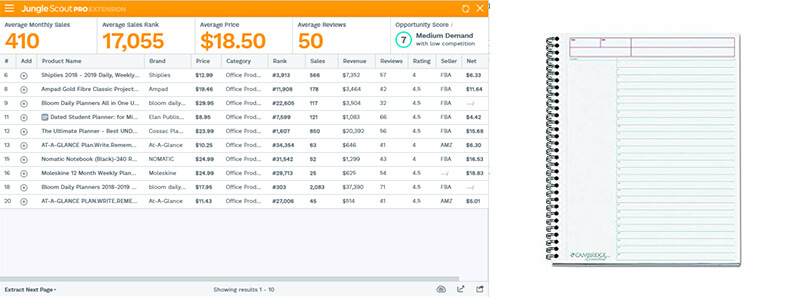
What I learned with the Jungle Scout Chrome Extension Pro:
- 410 average units in sales per month. Jimminy Christmas! Did we strike gold right from the get-go? Keep in mind, that’s AFTER I removed all the products that have reviews higher than 100!
- 50 average reviews. Still some high-high reviews even after removing those with more than 100. I’m guessing getting to the first page isn’t going to be easy with this niche. You’re probably going to want to look for those with reviews even less than that to really get a feel for what to expect. But still… that’s not bad at all.
- FBA fees are showing $4.71. And here comes the trouble with paper. Yes, it’s paper. And paper is light. But a lot of paper–like 250 pages worth of paper–is heavy. It is effectively a block of wood. And we’re going to want to sell a more expensive product because we want the bigger margins.
Oh boy oh boy. High sales, low’ish reviews… but big fat FBA fees?
The question is… WILL. IT. BLEND?
Whoops. Wrong catchphrase. IS. IT. PROFITABLE?
How much will these cost to manufacture?
So I want to go after some of the ones that have a whole bunch of pages in it. Like 250-365. That way we can mark ’em up quite a bit. Doing a quick search with our friends at Alibaba, I’ve found a few good options. Prices seem to hover around the $1.00 to $5.00 mark.
Something to note about this product. The nicer it is, the more likely you’re going to sell it for a higher price and get better reviews. Of course, the nicer it is, the more it’s going to cost from Alibaba.
Without sending a request-for-quote (RFQ), let’s say we can get these for $2.50 each at a higher-than-average order quantity. Were I to order the minimum order quantity (MOQ), we’d probably be looking at closer to $4-$5.
How many units would we need to order to compete?
Plugging in the details of one of the more expensive planners into OnPallet’s pallet calculator, I was pleasantly surprised to learn we can fit almost 1,500 of our planners on a single pallet. Heck yeah. So I’m going to say that’s the amount we should go for: 1450 of ’em. That’ll cover three months of sales, plus leave us with plenty to give away. Keyword Scout says we should give away about 140 of ’em over the course of 10 days. A single pallet will probably cost us about $1,200 (at least where I live in landlocked-frikkin’-Oklahama). That’ll be $0.82 per unit. Might as well round up to a dollar for any BS fees we might hit along the way.
Let’s check out our costs:
Cost estimation for Planner Notebooks
($2.50 per unit costs + $1.00 per unit shipping costs) x 1450 units
+ $300 in art, sample and mold fees
= $5,375 in total product costs
/ 1450 units
$3.70 per unit
Okay, things are still looking good. Time to do the ol’ matheroo to see if we can make some moolah with these.
What will our profit margins be for this product?
Let’s sell ours for $30. Why not? We’re going to make a cool product! So let’s ask for all the nickels. At $30, Amazon’s going to suck up $9.21 in fees for it (15% referral fee plus another $4.71 in shipping and handling). Then, we subtract our $3.70 in costs. That leaves us with $17.09 for ads and profit. Keyword Scout says that ads cost us $0.69 for exact matches and $0.51 for broad matches. Using our 2.5 Rule, both of those numbers are under $0.75. That means ads will probably cost us about $6.90, leaving us $10.19 for profit.
Uh, hell yes.
Before throwing up the verdict, a couple things I should point out:
- The products that seem to succeed on the front page are those that are “simple” in design. Still, make sure yours is nice.
- You’ll probably have to do a little graphic design work to make the pages nice and really pop.
- Get lots of samples from popular brands like Cambridge to see what they do. Then read the reviews to see the things that people don’t like about ’em.
- Remember… paper is heavy AF. Your shipping costs could vary wildly. Get plenty of quotes.
Verdict: You’re looking at up to $4,177.90 profit per month for a total of $50,134.80 per year. This could mean a potential ROI of 1032% (annual profit / first order costs + 1). This one is a super-duper winner.
2 – Personal Organizer (Opportunity 4)
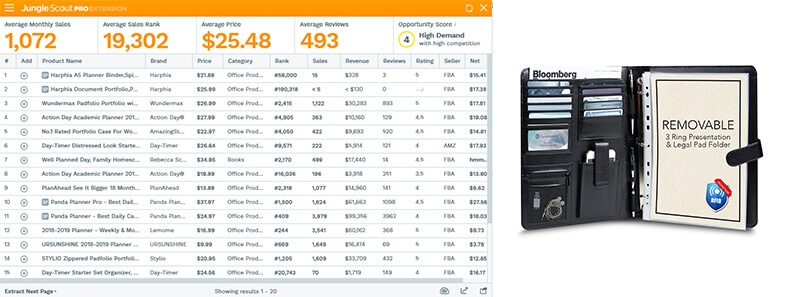
What I learned with the Jungle Scout Chrome Extension Pro:
- 1,072 average units in sales per month. Yaaaay!
- 493 average reviews. Boo! And all but, like 3 are above 100 on the first page.
- Average price is $25.48. Nice high price. But these things are super nice!
Yeah, this one already has the marks of a stinker. I’ve said it once and I’ll say it again: don’t let high volume products fool you! They are super super super SUPER competitive and you’ll quickly find yourself spending a whole lot of money for nothing. Another thing to note on this is that the one that’s got ads on it with 0 reviews is doing less than 5 sales per month. That’s a bad sign.
How much will these cost to manufacture?
Ah, so. The mystery unfolds. High volume product with cheap cost to source? No WONDER there’s so much competition. Looking at Alibaba, I can get low MOQs of these for $2-$4 per unit. And remember that the average sales price is pretty high, too!
How many units would we need to order to compete?
I’m not sure that I’d want to try to touch the high volume sellers here. So I’m going to do something a little different. Using the Web App’s product tracker feature, I’m going to use the Jungle Scout Chrome Extension’s extraction feature to pull the next few pages. Then, I’m going to sort those pages by Reviews in ascending order. After that, I’m going to figure out the average sales for those units. Furthermore, I’m going to delete those that are using ads and slim it down to just the 9 entries with the lowest number of reviews.
Digging deeper…
This should really give us a look at what new products are selling:
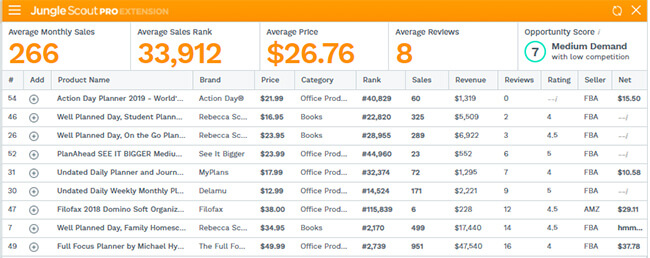
Quite different right? Notice their #s on the far left side. Only one of these is from page one, the “Well Planned Day, Family Homeschool Planner.” Also, those products appear two more times on this list. With the high volume of sales, I suspect that it’s coming from an outside source. Let’s do a look on the Googles and see what we can learn about the “Well Planned Day” series.
I did a search in some of my SEO tools for “homeschool planner” and learned that there’s about 3,000 searches per month on Google. Especially in the summer! But do those trends hold up year around?
Did you know that the Jungle Scout Chrome Extension can actually tell you how seasonal a product is? Check it out!
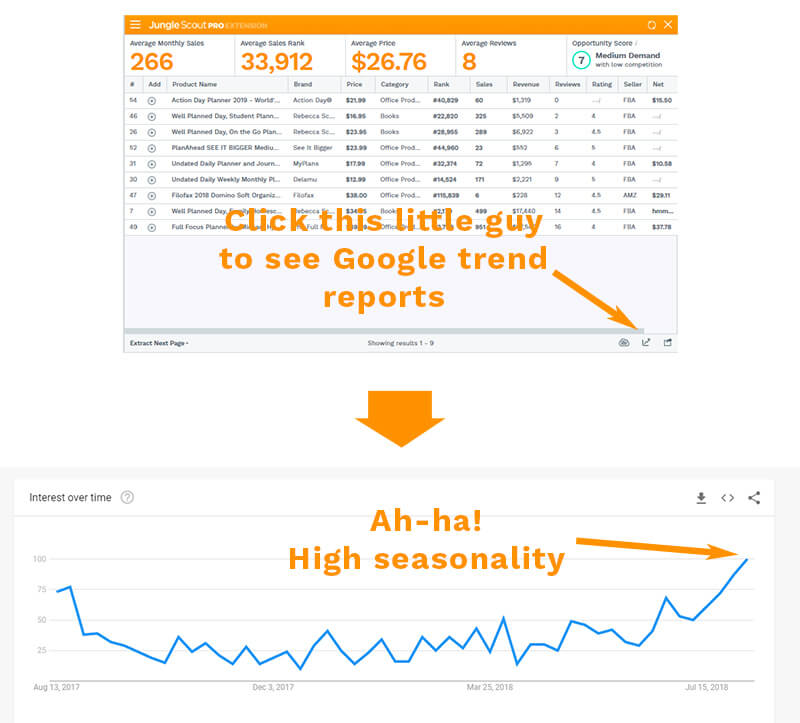
If you look at this chart, it shows us that during the summer “homeschool planner” does nearly 4x the normal Google traffic in this part of the year.
Why did Dave just pivot to another product?
Okay, so you might have noticed something here. I’ve kinda pivoted away from “personal organizer” to “homeschool planner.” We noticed right away that the category “personal organizer” was probably too difficult. But “homeschool planner” product that rank waaaaay waaaay down for “personal organizers” still do pretty well. Then, if we take that keyword and stick it into Keyword Scout, we can learn even more about those products and their competitiveness:
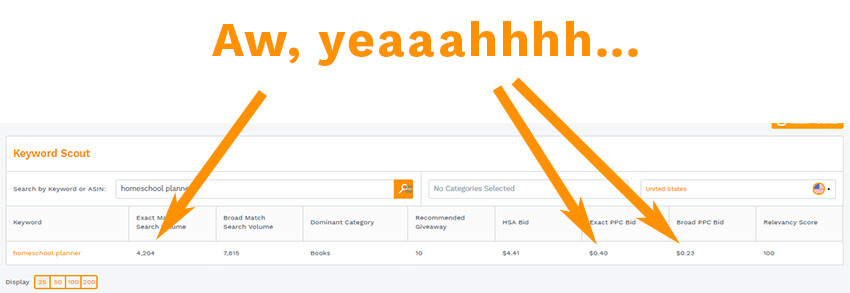
Now lookie what we found just hiding there in what probably should have been a stink-o category. Homeschool planners have over 4,000 searches per month with bids at $0.40 for exact and $0.23 for broad.
Throwing this particular keyword back into Amazon and using our JSP, let’s see what we come up with now…
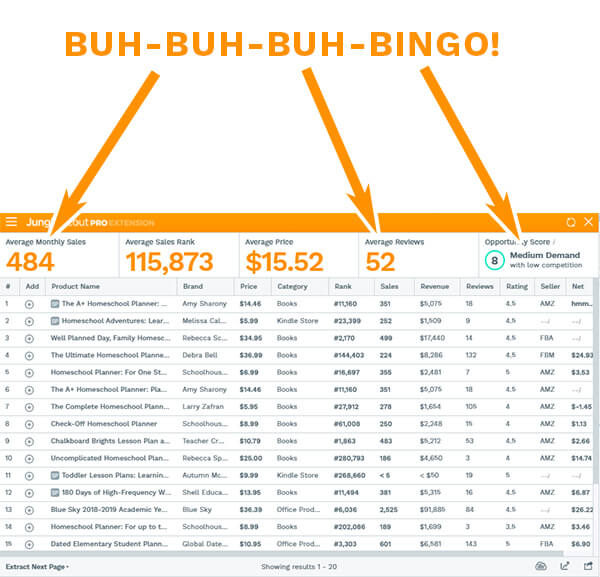
So, let’s start over…
2 – Personal Organizer (Opportunity 4) Homeschool Planner (Opportunity 8)
We can see above that our average sales are 484 per month with average price at $15.52 and only 52 average reviews. That’s an opportunity 8 product with no editing the list. I showed you before there’s some seasonality, so let’s cut our average sales down by half to get 242.
We already figured out that our costs are probably in the $2.50 range, and I’m guessing we can probably use the same OnPallet information from planner notebooks to get homeschool planners together.
How many units would we need to order to compete?
Keyword Scout says we gotta give away 100. And we’re going to need three months of these buggers to stay in stock between orders. So that’s putting us at about 826. Unfortunately, regardless of how much you put on a pallet, the cost for one pallet stays about the same: so $1200. That’s $1.45 per unit.
Cost estimation for Homeschool Planners
($2.50 per unit costs + $1.45 per unit shipping costs) x 826 units
+ $300 in art, sample and mold fees
= $3,562.70 in total product costs
/ 826 units
$4.31 per unit
Little bit higher than our last planners (mostly because we’re ordering less), but I think we’re going to end up saving money in some other areas, especially ads.
What will our profit margins be for this product?
We saw that these can sell for $24.99 or more, so let’s go with that nice number $24.99. Amazon will take $7.91 for their fees. Then we’re going to subtract $4.31 for our costs. That leaves us with $12.77 for ads and profit. But hey hey… remember those low ad costs? $0.40 for exact? The 2.5 Rule says we need to get clicks below $0.63, so we nailed that one for sure! That means our ads should shake out around $4.00 per unit. That gives us $8.77 in profit.
Final considerations:
- This is a seasonal product. So you’ll have to account for spikes and downturns in the product.
- Homeschooling is very big in the US Christian community due to separation of church and state laws. So this will be your primary target market.
- The top seller, Well Planned Gal, has a lot of good influencers promoting her product. You might want to consider those sources, too, especially since the homeschool community chats a lot.
- Sometimes you can find a product within a product with a few clever tricks. I’ll flesh this out more below.
Verdict: probably looking at close to $30,000 in profit in your first 12 months on this if you include all the peaks and valleys. I gotta say it’s a total winner. HOWEVER, that’s on “homeschool planner” and not “personal organizer.”
4 – Bullet Journal (Opportunity 4)
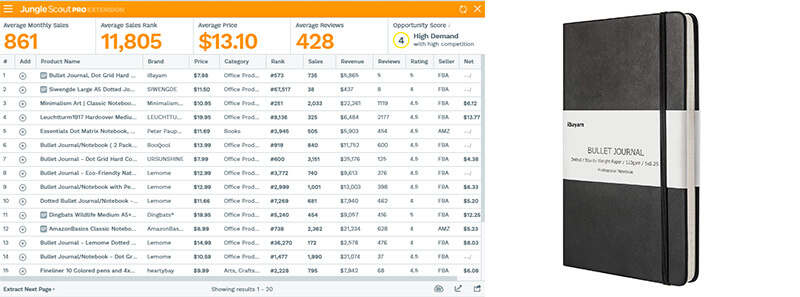
What I learned with the Jungle Scout Chrome Extension Pro:
- 861 average units in sales per month. Whoopie! High sales, yeaaaah!
- 428 average reviews. Aw shucks! Lots of reviews means lots of competitors.
- Average price is $13.10. And a lousy price, too. Hard to make margins there.
Deja vu, right? But maybe we can do the same trick we did before to find something worth selling in this mix? This time, I’ll plot out the steps for you. And let’s give this manuever a fancy name… like…
The Hamrick Trick!
aka How to Find High-Demand/Low-Competition Products in Any Category Using Jungle Scout in 20-Minutes or Less
Before we get started, just know you’ll need these two things:
- The Jungle Scout Chrome Extension Pro. It’s gotta be the pro versions, because the limited version doesn’t have some of the features we’re going to need to use. And no, it won’t work with our competitors’ products either (I’ve tried).
- A Jungle Scout Web App Subscription. This can be the starter package, although I recommend getting at least standard so you can use the Niche Hunter. Regardless, you’ll need access to the Web App’s Keyword Scout, tool, which, for my money, is the best Amazon product research tool on the market.
Once you’ve got these, just follow the steps below:
1 – Do a search for something on Amazon.
It can be anything, really. I’m going to use “bullet journal” as the example. Keep in mind, I’m doing all this research in real time. None of this information is pre-vetted. In fact, I’d never even heard about a “bullet journal” until Melissa Presti, one of our writers, suggested it.
2 – Use your Jungle Scout Chrome Extension Pro to see the initial results.
More likely than not, the Opportunity Score is going to be in the yellow 4-6 range on most searches you do. Don’t worry about that.
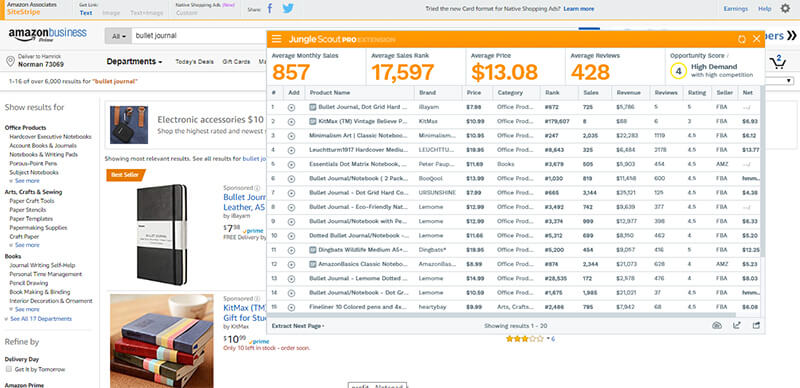
3 – Hit the ‘Extract Next Page’ button to load more results.
This will stick in about another 20 results from the second search page into the Chrome Extension.
You may notice that your results at the top will change. And that’s okay!
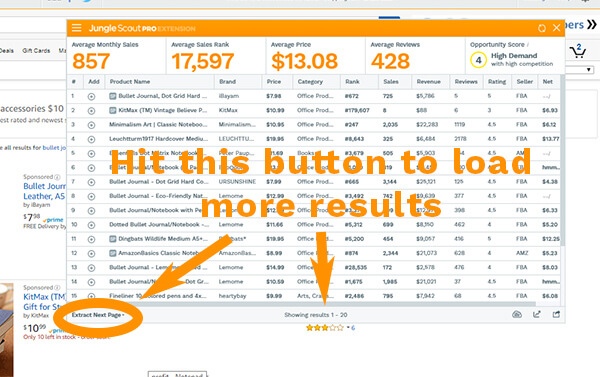
4 – Sort the Chrome Extension by reviews in ascending order.
That means you want the 0 reviews at the top and the highest reviewed product all the way at the bottom.
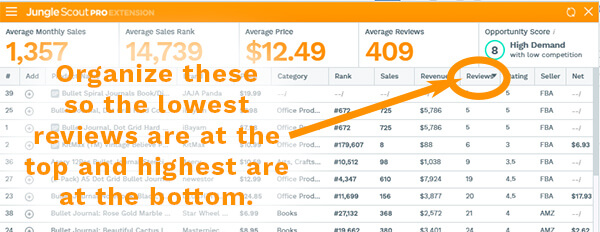
5 – Count the number of non-sponsored products that have review counts under 30.
If it’s less than 10, repeat steps 3-5 again. If it’s 10 or more, you can stop. But it must be non-sponsored ads!
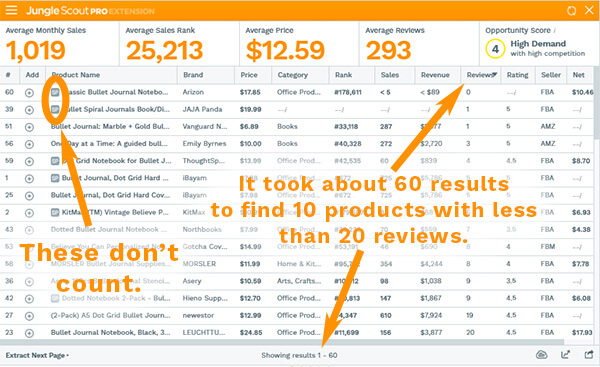
6 – Remove all of the products that have more than 30 reviews and/or sponsored products.
This might take a while, especially if there’s a lot of products in the listing. But trust me, it’s worth it.
Check out what I got:
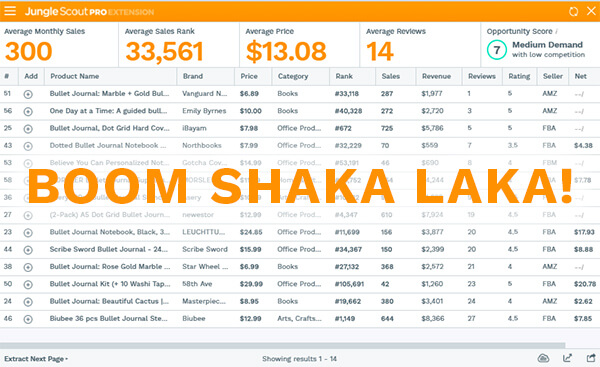
Looking good, looking good! But hey, we’re not out of the woods yet.
7 – Add all of these products to your product tracker.
You’ll want to see over the next few weeks if this is just a random occurrence on some of the products, or the real deal. And the Product Tracker isn’t estimations. It’s real sales info gathered from Amazon. Plus this is a whole lot easier than writing them all down in some spreadsheet you’re liable to lose.
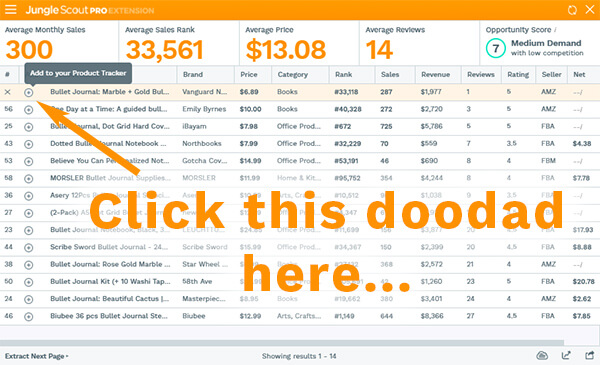
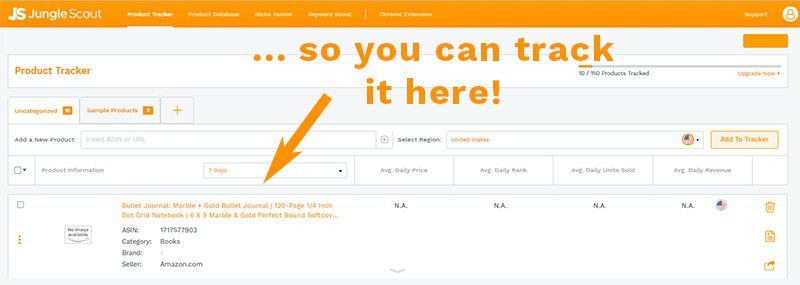
8 – Look for a product with a good price and no branded terms in the title; get its ASIN.
Next, we’re going to want to find a product that’s going to be our “model product.” I’m first going to pick the one that’s called (2-Pack) A5 Dot Grid Bullet Journal 100gsm Spiral Notebook 5.7 x 8.3 inches – 80 Sheets Per Book, Thick Dotted Paper, Wirebound. It’s an FBA product, and judging by the title, the sellers knows how to jam the keywords in.
This product is making about 610 sales per month with only 19 reviews. The price is a little lower than I like, but that’s okay. It can lead us to glory! Let’s see what’s up and why it’s making such good sales with so low reviews.
The ASIN is found in either the product’s URL or in the “Additional Information” box near the bottom of the listing (yes, I used a different product as an example).
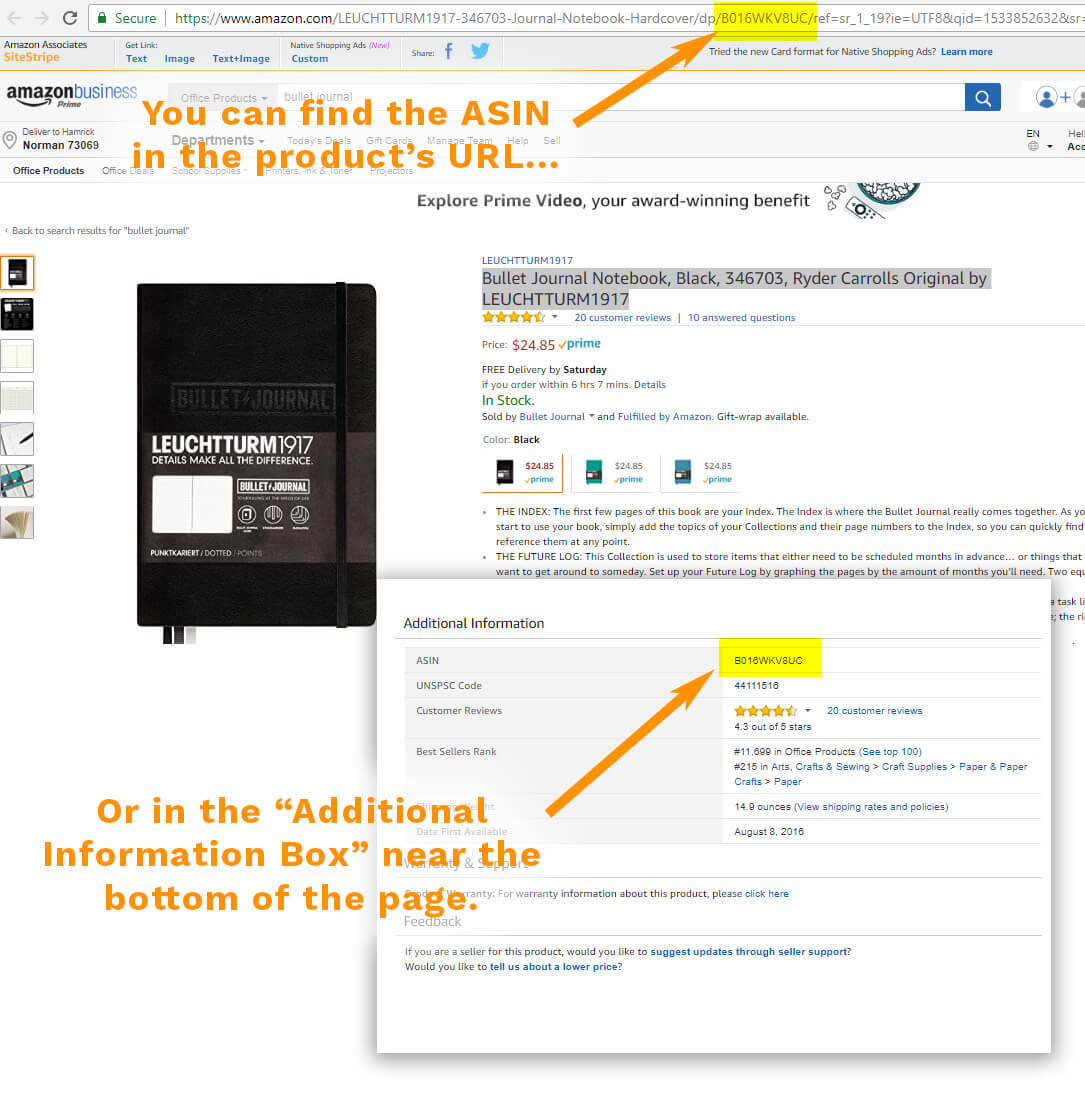
9 – Stick the ASIN into Keyword Scout in the Web App.
Now we’re going to do what’s called a Reverse ASIN Lookup. Essentially, it’s going to take the product page in question–like the one we just put in–and look up every single keyword and keyword phrase that this product ranks organically in the top 10 for.
Pretty neat, right?
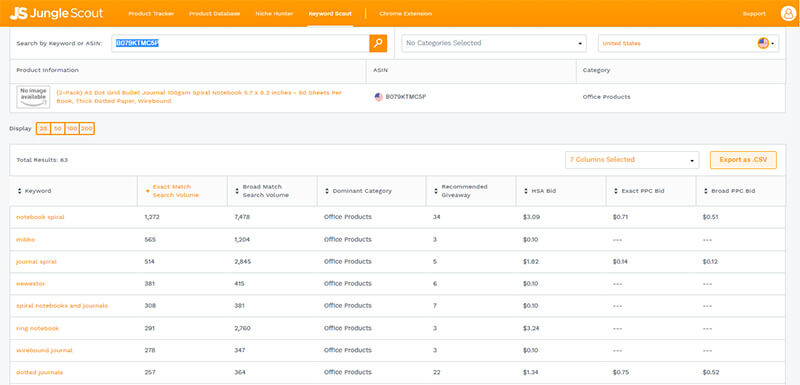
10 – Scan the keyword list for good keyword opportunities.
If we look here, we see that we’ve got a bunch of options. You’re going to want to find the keyword that’s got low exact and broad PPC costs relative to the number of searches. This is our “Trojan Horse”, the keyword that the seller is leaning on to make sales. And keep in mind, they probably use more than one of those keyword opportunities, too.
The first one I found right away is “journal spiral” with has 514 exact searches, 2,845 broad searches, but only has $0.14 and $0.12 for exact and broad bids respectively. Using our 2.5 Rule in reverse (multiply the costs by 10), that means we can probably spend $1.40 or $1.20 comfortably. And it also means we can probably price a product a lot lower than normal to compete.
11 – Use the keyword(s) to do a new search on Amazon.
I stuck the keyword in and right away it pops up as an opportunity 7 product with only 364 average monthly sales and 78 average reviews. And remember, Keyword Scout told us that this thing gets a ton of searches, too.
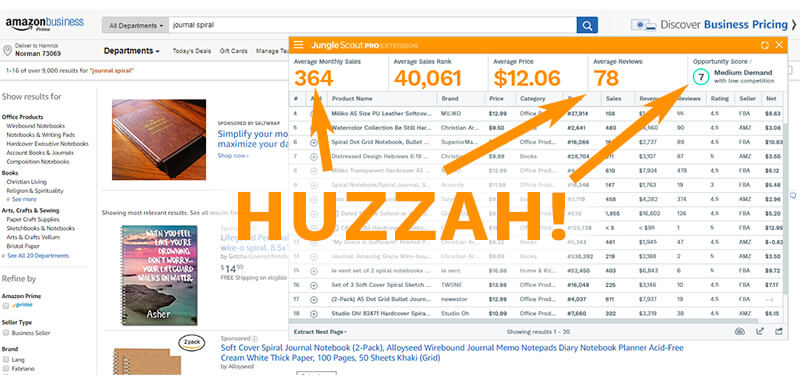
Why does the Hamrick Trick work?
Thanks to the Hamrick Trick, we can use the Jungle Scout Chrome Extension Pro and the Web App to take a lousy product and turn it into a good one in about 20 minutes. Sure, this doesn’t account for costs yet, so there’s no guarantee that the product is profitable, but what it DOES do is help us find products that are making good sales with low reviews quickly.
We find these products way in the back of the categories we’re interested in because they’re getting long tail boosts from their huge sales volume. “Okay, Dave, what does that mean?” Essentially, Amazon finds the product so good, it thinks it should rank for related stuff. In this case, this two pack of bullet journals was doing so well in “journal spiral” that it also showed up in searches for an incredibly competitive category like “bullet planner.” It’s not page one of bullet planner, mind you, but it doesn’t have to be. Because it’s ranking in the Top 10 for 63 more phrases!
The key is in finding which keywords that particular product is sneaking through the system with (our so-called “Trojan Horse”) so you can reverse engineer their marketing efforts. In this case, the seller–whether they were aware or not–discovered that “journal spiral” is worth betting on. It’s got high searches and relatively low bid costs. The perfect opportunity!
Back to our product opportunity…
Okay, so we’re now going to target “journal spiral.” Our new search results show us that the average price is around $12.06, which isn’t great, right? But if we look real quick we can see there’s some other products with low reviews making killer sales priced in the $16-$18 range. So let’s price ours there.
How much will these cost to manufacture?
Turning to Alibaba, you can see that we can find these guys for as low as $1.00 per unit (HOLY SH-). We probably want to do a two pack like the other higher priced ones, so we’re looking at $2.00 per unit. But that effectively cuts our MOQs in half, right? So that gives us some options.
How many units would we need to order to compete?
At around 300 sales per month, we probably want to order 900 units (that’s 1,800 notebooks) plus some for giveaways. Looks like it’s 5 per day for 10 days for giveaways, but let’s just bump it up to a nice even 100. That’ll give us 1,000 units or a total of 2,000 notebooks.
However! OnPallet says we can fit 700 units onto a pallet. Personally, I don’t want to get two pallets. So I’m going to cut our order back down to 700 units and just hope we don’t sell more than 200 per month (#sellerproblems). That’s going to add another $1,200 to our cost of goods, or $1.71. Blech, kinda high… but paper is heavy, remember?
Cost estimation for Spiral Journals
($2.00 per unit costs + $1.71 per unit shipping costs) x 700 units
+ $300 in art, sample and mold fees
= $2,897.00 in total product costs
/ 700 units
$4.13 per unit
Woof. A little high for our low prices, but I think we can make it work.
What will our profit margins be for this product?
Okay, so we’re shooting for $17.95 as our price. Amazon’s taking $7.40 from the start. And then we’re going to spend $4.13 in unit costs. And finally, ad costs are going to shake out to be around $1.40. That leaves $5.02 in profit. Not the best in the world, but hey… profit is profit! And our model product is selling, like… 600 of these two packs per month!
Verdict: You could earn $5.02 per unit at 200 (and maybe eventually 600) units per month for $1,004 in profit. I’d call spiral journals a winner (even if bullet journals were not).
5 – Graph Paper Journal (Opportunity 4)
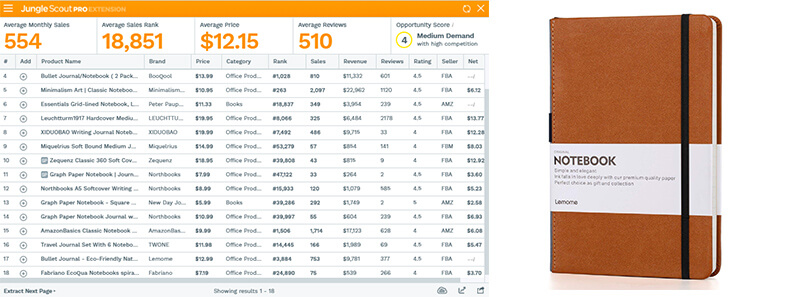
What I learned with the Jungle Scout Chrome Extension Pro:
- 554 average units in sales per month. Uh oh, here we go again… high sales annnddd….
- 510 average reviews. … high reviews to match.
- Average price of $12.15. And a low price to boot.
This is the point where in past editions of “What to Sell on Amazon” I’d throw in the proverbial towel. But now we know The Hamrick Trick (trademark pending!), don’t we?
I won’t throw up all the graphics again, but here’s what I did:
- I extracted the next page of results and immediately found a product selling 49 units per month on only 3 reviews at a price of $16.99. It had no branded terms in the title and was from an FBA seller. So I knew I could reverse engineer it.
- Taking the ASIN from my model product, I did a reverse ASIN lookup using Keyword Scout. That gave me 40 keywords to work with.
- The one that jumped out right away was “large square notebook.” Probably because I’m a large square? But I digress. It had decent searches but super low exact searches at $0.05 each.
- I took “large square notebook” and put it back into Amazon and drumroll, please…
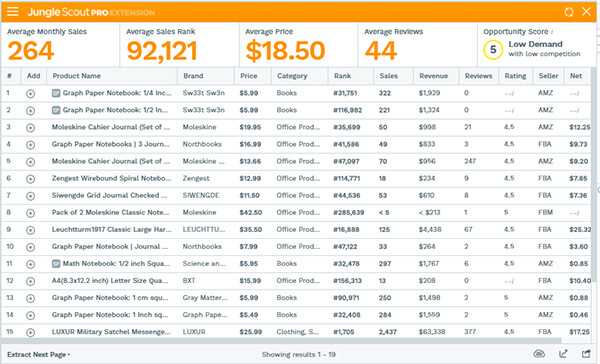
Opportunity Score 5? Not great! But look at the average sales, review, and price. Plus, all of the reviews are in the single digits. Ladies and gentleman, this is shaping up to be a good little product.
How much will these cost to manufacture?
Turning to Alibaba, I’m seeing low prices again. About $1.00 or less per notebook. I want to do a three pack because that’s how my product model did theirs. So that’s 3 notebooks per unit. So my raw cost is already $3.00.
How many units would we need to order to compete?
The Chrome Extension Pro says we’re going to average 264 units per month in sales. Our model product is doing less at 49. So I’m going to shoot for 150 units plus giveaways. That means I’ll need to order 450 notebooks (remember, they’re all in 3-packs) plus another 50 for giveaways. So 500 total.
On pallet says I can fit 544 triple packs onto a pallet. So that’s perfect!
Cost estimation for Large Square Journal
($3.00 per unit costs + $2.40 per unit shipping costs) x 500 units
+ $300 in art, sample and mold fees
= $3,000.00 in total product costs
/ 500 units
$6.00 per unit
Kind of an ugly price point, but that’s okay. Let’s see if it’s profitable:
What will our profit margins be for this product?
If we price ours around what the average for “large square notebook”, then we can probably get a comfortable $18.99 for our three notebook pack. That means Amazon’s going to take $7.56 for their fees and we need to take out the $6.00 in costs. That leaves us a crummy $5.43 for ads and profit. On the keyword “large square notebook” we’ve got clicks down to $0.05 for exact, so that’s only $0.50 in ad costs for that keyword. However, “large square notebook” only gets about 150 searches per month, so we’re going to need some more keywords. But as long as we’re under our total margin of $5.43, we’ll make profit. That gives us a berth of $0.54 per click.
Verdict: again, we turned a loser into a winner (even if it’s a so-so winner).
What to Sell on Amazon Concludes!
That’s it for this week! With your help, I’ve invented a new technique for finding profitable products within losing products. Remember The Hamrick Trick the next time you’re checking out a loser and you may soon find yourself with a winner!
And don’t forget, you can’t do the Hamrick Trick without Jungle Scout–and Jungle Scout alone’s tools. If you don’t already have ’em yet, you should probably stop reading this series, ’cause all you’re doing is daydreaming, friend! Stop dreaming and start living!
Get the dag’on Jungle Scout Chrome Extension Pro and The Web App today!
If you haven’t read the other editions, go out and give ’em a read now:
Oh, and speaking of WHAT TO SELL ON AMAZON be sure to check out the BRAND SPANKING NEW MILLION DOLLAR CASE STUDY!
Greg’s at it again, showing sellers how a million dollar seller like himself finds a product, sources it, and launches it. I might be an expert, but that dude is a sourcing GENIUS. And he’s joined with probably the most charismatic dude I’ve ever met (and also a 2-year Amazon seller) Rolando Galeana.
GO! SIGN UP! NOW!
Make sure you tune in!
If you have any questions or product suggestions, feel free to email me direct: [email protected].
See ya!
